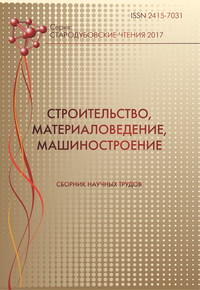Obtaining details from titanium alloys by additive methods
Keywords:
additive technologies, titanium alloy, surfacing, structure, microhardnessAbstract
Annotation. Purpose. Investigation of the structure and microhardness of a sample obtained by the additive surfacing of a powder of a titanium alloy VT20 on a substrate of the alloy VT1-0. Methodology. Installation for surfacing type SV-212M. The powder of the titanium alloy VT20 is a non-spherical particle shape, fractions -160 + 40 μm. The structure and microhardness were studied. Findings. Electron-beam surfacing of VT20 alloy powder is carried out. The size of the transition zone, which was 4 mm and the microhardness of 2000-3000 MPa was established. The absence of discontinuities in the form of layer-by-layer non-melting of the powder is established. The structure of the deposited layer was found to be of the 4-th type according to the 9-type scale of microstructures (GOST 26492-85) with microhardness of 3000-3600 MPa. Originality. A bond between structure and microhardness was established for the VT20 titanium alloy deposited by additive technology in domestic conditions. Practical value. The additive surfacing in the domestic conditions of samples of the titanium alloy VT20 is realized.References
Petrik I.A. Development of powders of titanium alloys for additive technologies as applied to GTE details. Petrik, A.V. Ovchinnikov, A.G. Seliverstov // Aviation and space technology and technology - 2015 - № 8 - p. 11-16.
Akhonin S.V. 3D electron beam surfacing of titanium components // SV. Akhonin, E.L. Vrzhizhevsky, V.Yu. Belous, I.K. Petrichenko // Automatic welding - 2016 - №5-6. - p. 141-144.
Production of hydrogenated sponge titanium powders. // the site of GP "GNIIP Institute of Titanium" [Electronic resource]. Access mode: http://timag.org/en_propose.php - 01/25/2017.
Skrebtsov A.A. Preparation of blanks for the manufacture of powders of alloyed titanium alloys for additive technologies. A.A. Skrebtsov, A.V. Ovchinnikov // Titan 2016: virobnitsvota vikoristanna in aviabuduvanni: theses of the dopas. IV of the international scientific and practical conference, 3-4 leaves of the fall of 2016, metro Zaporizhzhya. - AT «Motor Sich»: [ISBN 978-966-2906-61-5], 2016. - p. 13-17.
Vydehi Arun Joshi. Titanium alloys: an atlas of structures and fracture features / Vydehi Arun Joshi. – London: New York: Taylor & Francis Group, 2006. – 227 р.
Downloads
Published
Issue
Section
License
Редакція Видання категорично засуджує прояви плагіату в статтях та вживає всіх можливих заходів для його недопущення. Плагіат розглядається як форма порушення авторських прав і наукової етики.
При виявлені у статті більш ніж 25% запозиченого тексту без відповідних посилань та використання лапок, стаття кваліфікується як така, що містить плагіат. У цьому випадку стаття більше не розглядається редакцією, а автор отримує перше попередження.
Автори, в статтях яких повторно виявлено плагіат, не зможуть публікуватися в усіх журналах Видавництва ДВНЗ «Придніпровська державна академія будівництва та архітектури».
Автори, які публікуються у цьому журналі, погоджуються з наступними умовами:
- Автори залишають за собою право на авторство своєї роботи та передають журналу право першої публікації цієї роботи на умовах ліцензії Creative Commons Attribution License, котра дозволяє іншим особам вільно розповсюджувати опубліковану роботу з обов'язковим посиланням на авторів оригінальної роботи та першу публікацію роботи у цьому журналі.
- Автори мають право укладати самостійні додаткові угоди щодо неексклюзивного розповсюдження роботи у тому вигляді, в якому вона була опублікована цим журналом (наприклад, розміщувати роботу в електронному сховищі установи або публікувати у складі монографії), за умови збереження посилання на першу публікацію роботи у цьому журналі.
- Політика журналу дозволяє і заохочує розміщення авторами в мережі Інтернет (наприклад, у сховищах установ або на особистих веб-сайтах) рукопису роботи, як до подання цього рукопису до редакції, так і під час його редакційного опрацювання, оскільки це сприяє виникненню продуктивної наукової дискусії та позитивно позначається на оперативності та динаміці цитування опублікованої роботи (див. The Effect of Open Access).

